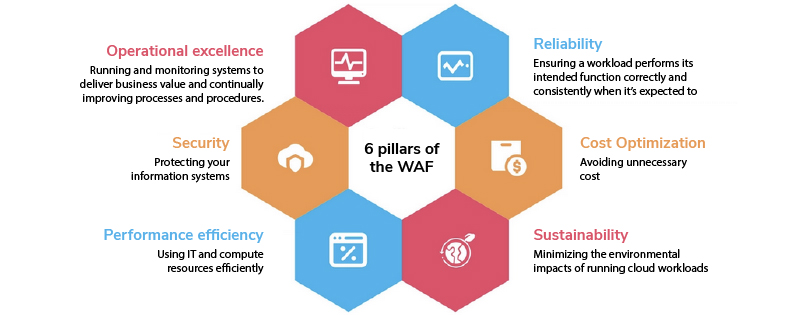
Best Practices for Designing Secure and Compliant AWS Well-Architected Framework
The AWS WAF (well-architecture framework) assists cloud architects in building dependable, secure, high-performance infrastructure for a variety of workloads and applications. A well-designed framework focuses on six pillars: operational excellence, security, dependability, performance efficiency, cost optimization, and sustainability. It offers clients and partners a standardized way of evaluating architectures and implementing scalable ideas.
Domain-specific lenses, hands-on labs, and the AWS Well-Architected Tool are all part of the AWS Well-Architected Framework. The AWS Well-Architected Tool, which is free to use in the AWS Management Console, provides a method for analysing workloads on a regular basis, detecting high-risk concerns, and documenting fixes.
AWS also gives access to an ecosystem of hundreds of AWS Well-Architected Partner Program members to engage a local partner to assist you in analysing and reviewing your applications.
Benefits of AWS Well-Architected Framework
Building a software system is equal to building a house. If the foundation is not strong, structural difficulties could affect the building's stability and operation. So, ignoring the six pillars while developing technological solutions on Amazon Web Services (AWS) could make it difficult to build a system that meets your expectations and requirements.
Integrating these pillars into your architecture helps in the creation of reliable and efficient systems. This frees you up to concentrate on other parts of design, such as functional needs.
The framework provides a uniform way for customers and AWS Partners to analyse architectures, as well as recommendations on how to deploy designs that scale with your application's demands over time.

1. Operational Excellence
The Operational Excellence pillar provides the capacity to support development, execute the workloads effectively, get insights into their operation, and constantly enhance supporting processes and procedures to generate business value.
Design Principles
- Perform operations as code
- Make frequent, small, reversible changes
- Refine operations procedures frequently
- Anticipate failure
- Learn from all operational failures
Best Practices
The operations team must understand the business and client requirements to support the business outcomes. The team develops and implements processes to respond to operational events and verifies their efficacy in meeting business requirements. The team also gathers metrics that are used to track progress towards intended business targets.
As everything is changing in your business context, priorities, and consumer demands. It is critical to design operations in such a way that they can evolve over time in response to change, as well as incorporate lessons learned from their performance.
2. Security
The Security pillar provides the capacity to safeguard data, systems, and assets to take advantage of the cloud technologies to increase security.
Design Principles
- Implement a strong identity foundation
- Enable traceability
- Apply security at all layers
- Automate security best practices
- Protect in transit data and at rest data
- Keep people away from data
- Prepare for security events
Best Practices
Before you establish any workload, you must implement security-related practises. You will want to limit who has access to what. You also want to be able to detect security issues, safeguard your systems and services, and ensure data confidentiality and integrity through data protection. Responding to security issues should be a well-defined and practised process. These methods and approaches are crucial because they help achieve goals like reducing financial loss or meeting regulatory requirements.
The AWS shared responsibility model helps cloud-adopting businesses to satisfy their security and compliance goals. You can focus on utilizing the services as an AWS client since AWS physically secures the infrastructure that underpins cloud services. The AWS Cloud provides easier access to security data and an automatic response to security occurrences.
3. Reliability
The workload's capacity to carry out its intended function accurately and consistently as anticipated is referred to by the Reliability pillar. This entails being able to run and test the workload during its entire life cycle.
Design Principles
- Automatically recover from failure
- Test recovery procedures
- Increase aggregate workload availability by scaling horizontally
- Stop guessing capacity
- Manage change in automation
Best Practices
Before developing any software system, it is important to ensure that the underlying needs for dependability are met, such as adequate network bandwidth in the data center.
Most essential criteria are already met by AWS or may be met immediately. AWS is responsible for providing enough networking and computation capacity in their nearly limitless cloud environment. Architectural decisions made during early software and infrastructure design impact workload behaviour across all six AWS Well-Architected pillars.
To ensure reliability, principles such as loosely linked dependencies, gentle degradation, and limited retries must be followed, and changes must be foreseen and adjusted. Establishing workload resilience through fault isolation, automatic failover, and disaster recovery planning is crucial, as failures can potentially affect the workload regardless of the cloud provider.
4. Performance Efficiency
The Performance Efficiency Pillar provides the ability to employ computing resources effectively to meet the system requirements, as well as the ability to sustain the efficiency, as the demand changes and technologies advance are all part of the performance efficiency pillar.
Design Principles
- Democratize advanced technologies
- Go global in minutes
- Use serverless architectures
- Experiment more often
- Consider mechanical sympathy
Best Practices
Create a high-performance design using a data-driven methodology and gather data on every aspect of the architecture, including the choice and configuration of resource types as well as the high-level design.
Regularly reviewing your decisions will guarantee that you are utilising the constantly evolving AWS Cloud. Monitoring makes sure you're aware of any deviation from the performance you expect. Make use of architectural trade-offs to increase performance, such as using caching or compression, or reducing consistency constraints.
The solution varies depending on the workload, and solutions frequently incorporate many methods. Performance is increased by using a variety of solutions and features that are enabled by AWS Well-Architected workloads.
5. Cost Optimization
The Cost Optimization pillar provides the ability to run systems to deliver business value at the lowest price point.
Design Principles
- Implement cloud financial management
- Adopt a consumption model
- Measure overall efficiency
- Cut expenses on undifferentiated heavy lifting
- Analyse and attribute expenditure
Best Practices
Like with the other pillars, there are trade-offs to be considered. Do you want to prioritize speed to market or cost effectiveness, for instance? In some circumstances, it is preferable to invest into speed optimization, such as releasing new features quickly or simply meeting deadlines than to invest towards upfront cost optimization.
Design decisions are frequently influenced by haste rather than facts, and there is always the temptation to overcompensate rather than spend time benchmarking for the most cost-effective deployment. As a result, installations may be over-provisioned and under-optimized.
Using the right services, resources, and configurations for your workloads is important to reducing costs.
6. Sustainability
The discipline of sustainability addresses the long-term environmental, economic, and societal impact of all your business activities.
Design Principles
- Understand your impact
- Establish sustainability goals
- Maximize utilization
- Anticipate and adopt new or more efficient hardware and software offerings
- Use managed services
- Minimize the downstream impact of your cloud workloads
Best Practices
To ensure sustainability, choose AWS Regions for your workloads and identify areas for improvement through user behaviour patterns.
Scale down infrastructure, position resources strategically, and delete unused assets. Optimize workload components by implementing load smoothing software and architecture paradigms and analysing their performance. Lower storage needs by analysing data trends and using lifecycle capabilities to shift data to more efficient storage and dispose of unneeded data.
Reduce hardware requirements by analysing hardware trends and selecting the most efficient hardware. Implement modifications to improve performance efficiencies and manage sustainability implications during development and deployment. Automate the management of development and test environments and test with managed device farms to further reduce sustainability impact.
About the Author
 Silambarasan Krishnan has over 18 years of expertise in Enterprise Cloud Services platform at Sensiple. He is presently the Principal Architect for "AWS and GCP Enterprise cloud services" Practice.
Silambarasan Krishnan has over 18 years of expertise in Enterprise Cloud Services platform at Sensiple. He is presently the Principal Architect for "AWS and GCP Enterprise cloud services" Practice.


